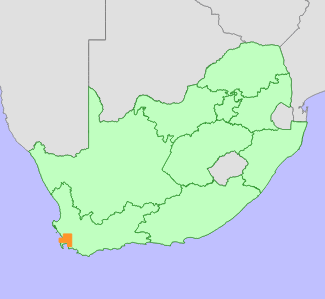|
Scientific Name | Athanasia capitata (L.) L. |
Higher Classification | Dicotyledons |
Family | ASTERACEAE |
Synonyms | Athanasia capitata (L.) L. var. glabrata Harv., Athanasia lanuginosa Cav., Athanasia punctata P.J.Bergius, Holophyllum capitatum (L.) Less., Holophyllum capitatum (L.) Less. var. glabratum DC., Holophyllum lanuginosum (Cav.) DC., Holophyllum scabrum DC., Pristocarpha capitata E.Mey. ex DC., Santolina capitata L. |
National Status |
Status and Criteria | Endangered A2bc; B1ab(ii,iii,iv,v) |
Assessment Date | 2010/11/23 |
Assessor(s) | D. Raimondo & N.A. Helme |
Justification | Formerly common on the Cape Peninsula and on the clay flats up the West Coast to Wellington (EOO <805 km²). This long-lived resprouter (generation length 50 years) has lost over 50% of known subpopulations and EOO over the past 120 years, primarily due to urban expansion, but also as a result of agriculture (vines and wheat) and alien plant invasion. The decline due to urban expansion is ongoing, especially around Durbanville, and is impacting all remaining severely fragmented subpopulations. |
Distribution |
Endemism | South African endemic |
Provincial distribution | Western Cape |
Range | Cape Town to Wellington. |
Habitat and Ecology |
Major system | Terrestrial |
Major habitats | Swartland Shale Renosterveld, Peninsula Shale Renosterveld, Swartland Granite Renosterveld, Swartland Silcrete Renosterveld, Montagu Shale Fynbos, Peninsula Granite Fynbos, Lourensford Alluvium Fynbos, Swartland Alluvium Fynbos |
Description | Seasonally wet clay flats or gentle slopes. |
Threats |
| Urban expansion has led to the loss of more than 50% of subpopulations represented by historical collections in areas around Cape Town and Wellington. It continues to decline in and around Durbanville, e.g. at the largest subpopulation at Uitkamp Wetland, where more than 60% of the site has been lost to urban housing development. Crop cultivation is a severe past and moderate ongoing threat for subpopulations occurring between Cape Town and Wellington, e.g. those occurring around Joostenberg Vlakte. Competition from invasive alien plants is a moderate ongoing threat throughout this species' range. |
Population |
This species seems to have become very rare, especially on the Cape Peninsula (Källersjö 1991). Most subpopulations are small, consisting of fewer than 50 plants, but there are two larger subpopulations, one at Uitkamp and one on the western slopes of Table Mountain.
|
Population trend | Decreasing |
Assessment History |
Taxon assessed |
Status and Criteria |
Citation/Red List version | | Athanasia capitata (L.) L. | EN A2abc; B1ab(ii,iii)+2ab(ii,iii) | Raimondo et al. (2009) | | Athanasia capitata (L.) L. | VU B1B2abc | Victor (2002) | | Athanasia capitata (L.) L. | Vulnerable | Hilton-Taylor (1996) | |
Bibliography |
Goldblatt, P. and Manning, J.C. 2000. Cape Plants: A conspectus of the Cape Flora of South Africa. Strelitzia 9. National Botanical Institute, Cape Town.
Hilton-Taylor, C. 1996. Red data list of southern African plants. Strelitzia 4. South African National Botanical Institute, Pretoria.
Källersjo, M. 1991. The genus Athanasia (Compositae - Anthemideae). Opera Botanica 106:1-75.
Raimondo, D., von Staden, L., Foden, W., Victor, J.E., Helme, N.A., Turner, R.C., Kamundi, D.A. and Manyama, P.A. 2009. Red List of South African Plants. Strelitzia 25. South African National Biodiversity Institute, Pretoria.
Victor, J.E. 2002. South Africa. In: J.S. Golding (ed), Southern African plant Red Data Lists. Southern African Botanical Diversity Network Report 14 (pp. 93-120), SABONET, Pretoria.
|
Citation |
| Raimondo, D. & Helme, N.A. 2010. Athanasia capitata (L.) L. National Assessment: Red List of South African Plants version . Accessed on 2025/05/31 |
 Comment on this assessment
Comment on this assessment


